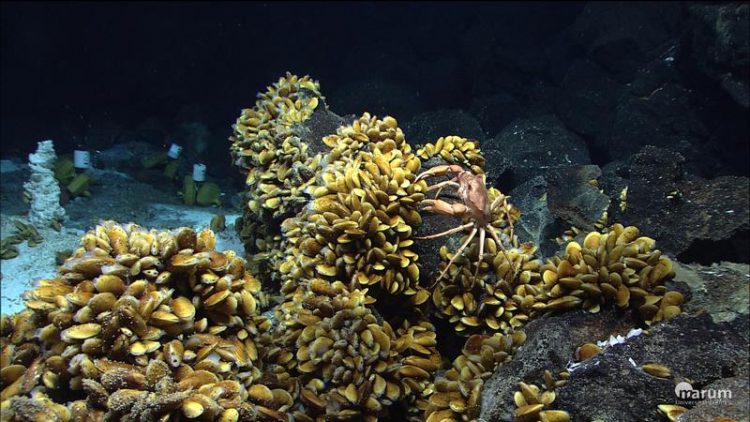Deep-sea mussels with highly toxic tenants

Bathymodiolus mussels at the Menez Gwen hydrothermal vent off the Azores, pictured during Meteor cruise M82/3. MARUM, University of Bremen/Germany
Imagine you have a tenant living in your house. They’re keeping your fridge topped up. But in addition to this, they’re producing all kinds of toxic substances. More harm than good? Not necessarily; it all depends what you’re using the toxins for.
Deep-sea hot vents are one of the most unusual habitats on Earth: At first sight they appear hostile and uninviting, but in fact, they are teeming oases of life. Likewise, their unique inhabitants are always surprising us. Find out how toxic tenants can also be beneficial in a new publication by an international research team led by Jillian Petersen from the Max Planck Institute (MPI) for Marine Microbiology, published in the open-access journal eLife.
Mussels of the genus Bathymodiolus, related to the well-known blue mussel, are among the most dominant inhabitants of hot vents in the deep ocean. In their gills, they house so-called chemoautrotrophic symbionts. These symbionts include sulfur-oxidizing bacteria, which convert substances normally not used by the mussels into tasty sugars.
Jillian Petersen and her colleagues have now taken a closer look at the genes that some of the symbiotic tenants of deep-sea mussels contain in their genomes. To their surprise, what they found was a vast array of hazardous substances. The symbiotic bacteria command an arsenal of genes that are responsible for the production of toxins. The number of toxins is impressive: With up to 60 toxins, the microorganism’s arsenal is better stocked than many nasty germs such as those that cause pest and cholera. However, down in the deep sea, the bacteria leave their host unharmed. In fact, they promote the health of their mussel hosts. How is this possible?
“We suspect that they bacteria have tamed these toxins”, explains Petersen. “Thus, they can now take advantage of them for the benefit their host.” Two kinds of beneficial effects of the toxins are possible: On the one hand, they might help mussels and bacteria to find and to recognize each other, essential steps to establishing a successful symbiosis. On the other hand, the toxins may help the mussel to defend itself against parasites.
“Symbioses are usually assumed to have only one benefit – the symbionts either help the host to feed or to defend itself. Our study shows that the partnership of Bathymodiolus and the sulfur-oxidizing bacteria seems to provide both: defence and food. That is very unusual”, emphasizes Lizbeth Sayavedra, who conducted the research as part of her doctoral thesis. The tenant not only fills the fridge, it also keeps the burglars out.
In the next steps, Petersen now wants to investigate the details of this defence mechanism. The research team has developed a method proving that at least one of the toxins is exported to the mussel tissue. “Our results give fresh impetus to the research on the role of parasites and pathogens in the deep sea”, says Petersen, who has recently established an independent research group at the University of Vienna.
“The Bathymodiolus symbionts produce more of these supposedly harmful substances than any known pathogen”, adds Liz Sayavedra. “Who knows – maybe one day we’ll discover that some of the genes that are currently annotated as toxins may have first evolved through such beneficial interactions.”
Fanni Aspetsberger
Original publication:
Sayavedra et al. (2015) Abundant toxin-related genes in the genomes of beneficial symbionts from deep-sea hydrothermal vent mussels. eLife 2015;10.7554/eLife.07966
Weitere Informationen:
http://www.mpi-bremen.de Website of the MPI
http://elifesciences.org/content/early/2015/09/14/eLife.07966 Original article
Media Contact
All latest news from the category: Life Sciences and Chemistry
Articles and reports from the Life Sciences and chemistry area deal with applied and basic research into modern biology, chemistry and human medicine.
Valuable information can be found on a range of life sciences fields including bacteriology, biochemistry, bionics, bioinformatics, biophysics, biotechnology, genetics, geobotany, human biology, marine biology, microbiology, molecular biology, cellular biology, zoology, bioinorganic chemistry, microchemistry and environmental chemistry.
Newest articles

Silicon Carbide Innovation Alliance to drive industrial-scale semiconductor work
Known for its ability to withstand extreme environments and high voltages, silicon carbide (SiC) is a semiconducting material made up of silicon and carbon atoms arranged into crystals that is…

New SPECT/CT technique shows impressive biomarker identification
…offers increased access for prostate cancer patients. A novel SPECT/CT acquisition method can accurately detect radiopharmaceutical biodistribution in a convenient manner for prostate cancer patients, opening the door for more…

How 3D printers can give robots a soft touch
Soft skin coverings and touch sensors have emerged as a promising feature for robots that are both safer and more intuitive for human interaction, but they are expensive and difficult…





















